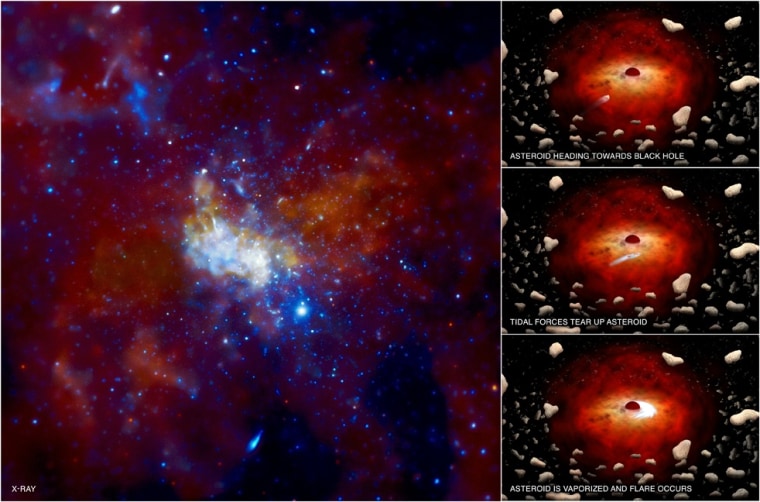The giant black hole at the center of our galaxy may be snacking on asteroids.
That’s the conclusion of a team of astronomers trying to figure out why the black hole, known as Sagittarius A*, flares with X-rays about once a day. The bursts range in brightness and typically last a few hours.
Scientists suspect there is a massive swarm of asteroids circling the black hole, objects that have been striped away or booted out from their respective solar systems. They estimate that asteroids passing within about 100 million miles of the black hole — about as far as Earth orbits the sun — would succumb to its gravitational grip and be torn to bits.
As the broken bodies flow through hot gases pouring into the black hole, they would vaporize, producing bursts of X-ray radiation. Any remains would eventually be swallowed by the black hole, which is estimated to contain about 4 million times the mass of the sun.
Over the years, scientists have come up with a few other theories to explain the X-ray flares. One is that there is a disk of material created by nearby stars that is giving off X-rays when it is hit by shock waves.
Another idea is that the X-rays come from blobs of magnetically stirred plasma flowing into the black hole.
“It’s been a mystery,” Peter Edmonds, an astronomer at the Harvard-Smithsonian Center for Astrophysics, told Discovery News. “Certainly there’s evidence for stars being torn apart by black holes, and asteroids are much more common than stars.”
The study also raises the question of what would happen to planets that drift into the black hole’s gravitational field.
Lead author Kastytis Zubovas of the University of Leicester in the United Kingdom said a planet’s demise might be the cause of a suspected massive X-ray burst from the black hole 100 years ago, an event that is still bouncing light off of nearby clouds.
"This would be a sudden end to the planet's life, a much more dramatic fate than the planets in our solar system ever will experience," Zubovas said, in a statement.
The research appears in the Monthly Notices of the Royal Astronomical Society.
